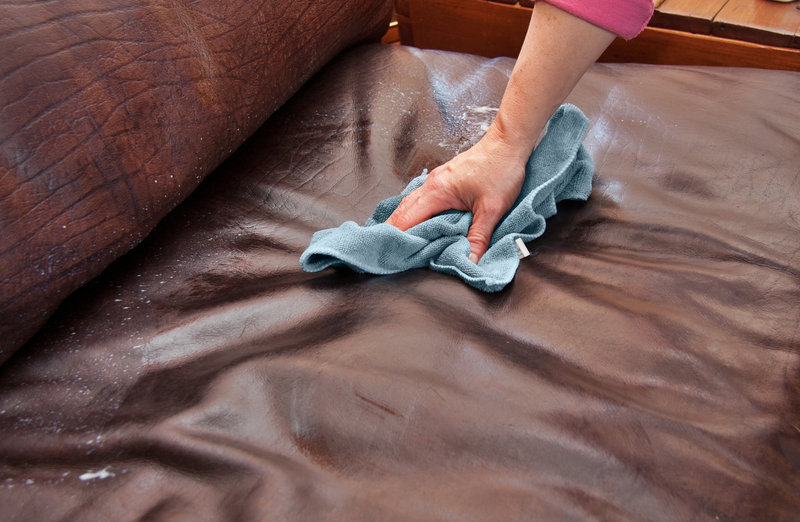Reclaim Freshness by Kicking Out Pet Odors
Posted on 15/06/2025
Reclaim Freshness by Kicking Out Pet Odors: Ultimate Guide to a Fresher Home
Is your house starting to smell more like your furry friend than a fresh sanctuary? Whether you own a playful pup or a cuddly cat, pet odors can sneak into every corner of your home. But don't worry--if you're determined to reclaim freshness by kicking out pet odors, this comprehensive guide is for you!
Understanding the Source of Pet Odors
Before you can truly banish stubborn pet odors and enjoy a fresher atmosphere, it's crucial to understand why and where these smells originate. Understanding the cause can help you develop effective solutions and prevent the issue from recurring.
- Pet Dander: Tiny flakes of skin, fur, and feathers are constantly shed by animals, becoming embedded in carpets, furniture, and air ducts.
- Accidents: Even the best-trained pets have occasional accidents, leaving invisible residues that result in persistent odors if not cleaned properly.
- Natural Oils and Saliva: Pets naturally secrete oils to keep their coats healthy, but these oils can get onto surfaces and fabrics.
- Litter Boxes and Cages: Pet waste is a significant source of unpleasant smells, especially if not managed promptly and regularly.
- Wet Fur: The infamous "wet dog smell" can cling to surfaces long after a walk in the rain or a bath.
The Importance of Addressing Pet Odors Quickly
Allowing pet odors to linger isn't just an aesthetic concern--it impacts the overall wellness of your household. Bad smells can:
- Reduce indoor air quality, potentially aggravating allergies and respiratory issues.
- Make your home less inviting for guests and family members alike.
- Encourage repeat marking or unwanted behaviors by your pets.
- Devalue your home's appeal if you are considering selling or renting.

Step-by-Step Action Plan to Kick Out Pet Odors
Ready to take back your space and kick out pet odors for good? Use this strategic, step-by-step approach:
1. Identify Problem Areas
Walk through your home with a sensitive nose and a keen eye. Common hot spots for lingering smells include:
- Carpets and area rugs
- Sofas, chairs, and curtains
- Pet beds and toys
- Crates, cages, and litter box areas
- Hidden corners or behind furniture where accidents may have gone unnoticed
Pro Tip: Use a handheld blacklight to spot invisible urine stains, particularly on fabrics or carpeted surfaces.
2. Deep Clean All Fabrics and Surfaces
- Launder all washable fabrics: This includes cushion covers, bedding (yours and your pet's!), throw blankets, and slipcovers. Always use an enzymatic cleaner or a mixture of baking soda and vinegar for added odor-fighting power.
- Carpet and Upholstery Cleaning: Invest in a steam cleaner or rent one for a powerful clean. For spot cleaning, use a pet-specific carpet cleaner designed to break down organic matter, the true source of most pet odors.
- Kitchens and Hard Floors: Mop hard surfaces with a disinfectant solution. Baking soda can also be sprinkled and then vacuumed to help absorb lingering odors.
3. Neutralize with Natural Deodorizers
While store-bought air fresheners may mask pet smells, neutralizing is key for true refreshment. Try these proven options:
- Baking Soda: Place open boxes in musty rooms and sprinkle over carpets before vacuuming.
- Activated Charcoal: Absorbs stubborn smells. Place small sachets in rooms or litter boxes.
- White Vinegar: Leave a bowl of vinegar out overnight for rooms with a persistent odor, or use it in cleaning sprays.
- Essential Oils: Safe oils like lavender or lemongrass can be used (in moderation and out of pet reach) to impart a fresh scent, but never apply directly to pets or places they inhabit.
4. Treat Pet-Specific Problem Zones
- Litter Boxes: Scoop daily, change litter frequently, and deep-clean the tray weekly. Use odor-controlling litter and consider adding baking soda to the mix.
- Pet Beds and Toys: Wash weekly with hot water and a pet-safe detergent. Old, worn-out beds and toys may need to be discarded.
- Crates and Cages: Disinfect with a pet-safe cleaner and allow to air dry weekly. Replace soiled bedding promptly.
5. Air Out and Purify Your Home
To truly reclaim freshness by kicking out pet odors, ventilation is crucial. Fresh air not only removes bad smells but improves your home's overall air quality.
- Open windows regularly, especially after cleaning.
- Use portable HEPA air purifiers in key rooms to filter pet dander and reduce odors.
- Replace HVAC filters every 2-3 months to trap particles and prevent recirculation of pet-smelling air.
Prevention Tips: Keep Odors from Returning
Consistency is key to preventing the return of unwanted pet smells. Adopt these practical habits:
Regular Grooming
- Bathe your pets according to veterinary recommendations, using a mild, pet-safe shampoo.
- Brush your pet regularly to remove excess fur and dander that contribute to odors.
- Pay special attention to ears, paws, and other areas prone to odor buildup.
Clean as You Go
- Wipe down muddy paws before they enter the house.
- Vacuum and mop floors weekly, focusing on high-traffic pet areas.
- Address accidents immediately with enzymatic cleaners to fully eliminate odor-causing bacteria.
Pet-Friendly Zones
- Consider designating pet-free rooms (such as guest bedrooms) to maintain at least one super-fresh sanctuary.
- Use washable covers on furniture and beds in pet zones for easy cleaning.
- Invest in odor-resistant materials such as leather or tightly-woven fabrics for pet-frequented areas.
Litter Box Best Practices
- Add a mat to catch stray litter and limit tracking.
- Ensure the box is neither too hidden nor too exposed--cats prefer accessible locations, while you want to minimize odor spread.
Products & Tools to Help Eliminate Pet Odors
Technology and innovation have brought a multitude of products to help reclaim freshness by removing pet odors. Consider incorporating these tools:
- Enzymatic Cleaners: As opposed to simple detergents, these break down organic waste at the molecular level, eliminating the root of pet smells.
- HEPA Air Purifiers: Traps microscopic dander and allergens, making the air fresher and healthier to breathe.
- Pet-Safe Odor Neutralizing Sprays: For a quick fix between deep cleans, these sprays instantly dissipate surface odors from fabric and hard surfaces.
- Robotic Vacuums: Set schedules to keep fur, dander, and dirt at bay with minimal effort.
- Automatic Litter Boxes: Keeps waste (and odors) concealed until disposal time, reducing daily maintenance and airborne smell.
- Washable Pet Beds: Opt for beds with removable, machine-washable covers for easier maintenance.
How to Choose the Right Products
Always check product labels to ensure they are non-toxic and safe for pets. When in doubt, consult your veterinarian.
Natural Solutions vs. Chemical Cleaners: What Works Best?
Every pet owner has a unique preference when tackling unpleasant scents. For some, natural remedies are preferred; others opt for heavy-duty commercial products. Here's a balanced look at both:
| Natural Deodorizers | Chemical Cleaners |
|---|---|
|
- Baking soda - Vinegar solutions - Activated charcoal - Lemon juice - Essential oils (use with caution) |
- Enzymatic pet stain removers - Commercial carpet deodorizers - Pet-safe disinfectants - Fabric sprays |
|
Pros: Non-toxic, eco-friendly, affordable Cons: May require more time/work, less effective on old/stubborn stains |
Pros: Fast acting, specifically engineered for pet messes Cons: May contain harsh chemicals, check pet safety before use |
In many cases, a combination approach is best. Use natural deodorizers for regular freshening and chemical cleaners for deep cleaning or stubborn messes.

Frequently Asked Questions: Pet Odor Solutions
Q1: How often should I deep clean my house to keep pet odors away?
A: Aim to deep clean high-traffic pet areas bi-weekly and do a full-house clean every two to three months. Complement with regular spot cleaning and laundering in between.
Q2: Do air purifiers really help with pet smells?
A: Yes! Air purifiers with HEPA filters are highly effective at trapping dander, hair, and tiny odor-causing particles, making your home feel fresher.
Q3: Can I use scented candles or sprays to mask pet odors?
A: While they offer temporary relief, candles and sprays don't eliminate the source. For best results, use them as a final layer after addressing the odor directly.
Q4: My cat keeps peeing in the same spot. What can I do?
A: Ensure thorough, enzymatic cleaning of the area to fully remove the scent marker. If it persists, consult a vet to rule out medical issues and reconsider litter box placement or cleanliness.
Q5: Is it safe to use essential oils around pets?
A: Some essential oils can be harmful to pets, especially cats. Research each oil and avoid direct contact with your animals. When in doubt, ask your veterinarian.
Conclusion: Make Your Home a Fresh Haven for All
Having pets doesn't mean giving up on a clean, inviting home. By following these steps to reclaim freshness and kick out pet odors, you'll create a space you're proud to share--with both guests and your four-legged friends. Remember, consistency, deep cleaning, and a touch of prevention are your strongest allies.
Take charge today--breathe easier, enjoy your favorite couch, and turn every corner of your home into an oasis of freshness!
Ready to reclaim freshness by kicking out pet odors in your home?
Start implementing these strategies today for a noticeably cleaner, more welcoming living space--even with your beloved pets by your side!




